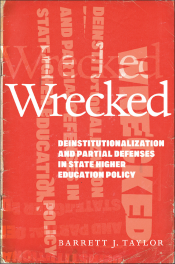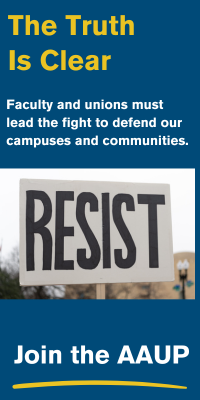- About
- Programs
- Issues
- Academic Freedom
- Political Attacks on Higher Education
- Resources on Collective Bargaining
- Shared Governance
- Campus Protests
- Faculty Compensation
- Racial Justice
- Diversity in Higher Ed
- Financial Crisis
- Privatization and OPMs
- Contingent Faculty Positions
- Tenure
- Workplace Issues
- Gender and Sexuality in Higher Ed
- Targeted Harassment
- Intellectual Property & Copyright
- Civility
- The Family and Medical Leave Act
- Pregnancy in the Academy
- Publications
- Data
- News
- Membership
- Chapters
Spring 2025: Trump 2.0
Understanding States’ Dismantling of Higher Education

Wrecked: Deinstitutionalization and Partial Defenses in State Higher Education Policy by Barrett J. Taylor. Rutgers University Press, 2022.
There is one book that, as a higher education scholar, I routinely recommend to colleagues seeking to better understand how higher education intersects with politics today: Barrett J. Taylor’s Wrecked: Deinstitutionalization and Partial Defenses in State Higher Education Policy.
In Wrecked, Taylor explains and illustrates how the combination of white rage and plutocratic impulses placed the political right and higher education on a collision course. As a result, the Right adopted a policy agenda of deinstitutionalization—that is, undermining the legitimacy of and confidence in public colleges and universities—that has sought to erode the material and social resources (money and trust) on which higher education depends. Instead of mounting effective defenses to reverse this erosion, many higher education leaders have pursued short-term budgetary wins by emphasizing the economic value of higher education.
This simple distillation of Taylor’s main argument belies the significant contributions of his analysis. Taylor is interested not in conflict between individual political actors but in the influence of social structure and how coalitions translated that structure into a policy focused on sweeping institutional destruction. One of two key structures he examines is whiteness and how conservatives came to present themselves as victims of government overreach and discrimination through affirmative action. For those on the right, raging at a system that, they claim, treats them unfairly is a defining narrative, according to Taylor; higher education institutions—whose student bodies have become increasingly diverse, thanks in part to federal policy—are one of their favorite targets.
The key second structure that Taylor addresses is extreme wealth concentration, which has led to the growing power of political elites whose primary goals have been low taxes and low government spending. He argues that the Right has always maintained close ties with moneyed interests and supported policies to diminish unions, cut taxes for the wealthy, and question the efficacy and efficiency of government programs designed to support public institutions. Deinstitutionalization as a policy agenda took shape along with the well-established trend of reduced government support for public higher education and a broader set of attacks. Higher education relies on legitimacy, and deinstitutionalization sows mistrust, compromises higher education’s independence, and questions what Taylor calls the “good faith of its core practices.”
To support these arguments and paint a picture of “life in the wreckage,” Taylor develops detailed case studies of four “crash sites,” or states that have witnessed both the “narrowing of the GOP into a smaller, angrier coalition that was increasingly hostile to nonpartisan institutions” and changing racial demographics that have contributed to more diverse enrollment at colleges and universities. These states are Arizona, Iowa, Wisconsin, and my own state of North Carolina. The case studies provide strong evidence for Taylor’s argument, although they stop short of providing a portrait of what it feels like to work and study in these states. At the same time, having spent the last decade teaching and researching higher education in North Carolina, I recognize that Taylor’s chronicle of higher education policy in my state is deeply researched and accurate.
Even if someone disagrees with the conclusions of Wrecked, few can question the facts themselves, which Taylor compiles and deploys effectively to capture the experience of working at a public university in the four case-study states. In fact, one of the book’s contributions is that it offers one of the few state-based political histories of higher education over the past two decades. Although the data on which Wrecked is based span 2008–18, Taylor wrote part of the book during the first Trump administration and amid pandemic-era politics. Perhaps that context informed how he approached the book and his sense of how the political winds were blowing. Part of the reason I continue to recommend Wrecked is that its salience has only increased since its publication in 2022. My hunch as I wrote this review was that Taylor would neither be surprised that his argument had held up nor happy about its continued relevance.
Here’s how Taylor responded when I asked him by email to comment on the enduring relevance of Wrecked: “I think the basic forces described in the book are still at work. In many cases, however, those forces are no longer solely focused on wrecking public higher education. Some state governments now seem intent on capturing colleges and universities through mandating and banning academic content, changing the conditions of faculty tenure, or placing political partisans in leadership positions. Although the underlying argument about partisan hostility to nonpartisan higher education holds, it has played out in ways I did not expect.”
The partial defenses that Taylor critiques have now been used for several decades, not only by campus leaders but also by membership associations, such as the American Council on Education, and philanthropic organizations, such as the Lumina Foundation. More recently, these partial defenses have come in the form of instrumental framings of higher education’s value and efforts to study the “return on investment” of a college education. Taylor’s implicit question throughout Wrecked is to ask where, precisely, these defenses have left those of us cleaning up the rubble of wreckage on our campuses. Reading Wrecked and reflecting on continued attacks on higher education, I found it difficult not to conclude that the economically based partial defenses to yield a secure future for academic institutions, and the communities they serve, have failed utterly.
In the book’s conclusion, Taylor takes up a more morally grounded defense of higher education. Drawing on the work of political philosopher Danielle Allen, Taylor argues that “education for a democratic society should be cultivated for the things only education can do—that is, for its intrinsic properties.” What are some things education does? It prepares students for citizenship, reveals how political conditions affect the flourishing of civil society, and encourages deep engagement with different communities and across social divisions.
We must, in Taylor’s estimation, constantly remind ourselves that “democracy . . . is more than formal governance by elected officials; it is a vibrant civil society in which a robust public life can be cultivated.” As Taylor noted in our email exchange, “A defense rooted in the question of what higher education looks like in an inclusive democratic society understands education not as a means to an end but as a core component of the end itself.”
And all of us have a role to play in this type of defense. Taylor’s parting words are not directed solely at institutional administrators. He calls on those of us who study and teach about higher education to become less anchored to studies of “what works,” which tend to be “inevitably transactional” and “exist within an instrumental narrative of partial defenses.” Instead, we must more fully engage in debates about higher education’s core purposes and build into our research and teaching a more robust defense of higher education based on its intrinsic value.
Kevin R. McClure is associate professor of higher education at the University of North Carolina at Wilmington and codirector of the Alliance of Regional Colleges. His email address is mcclurek@uncw.edu.








